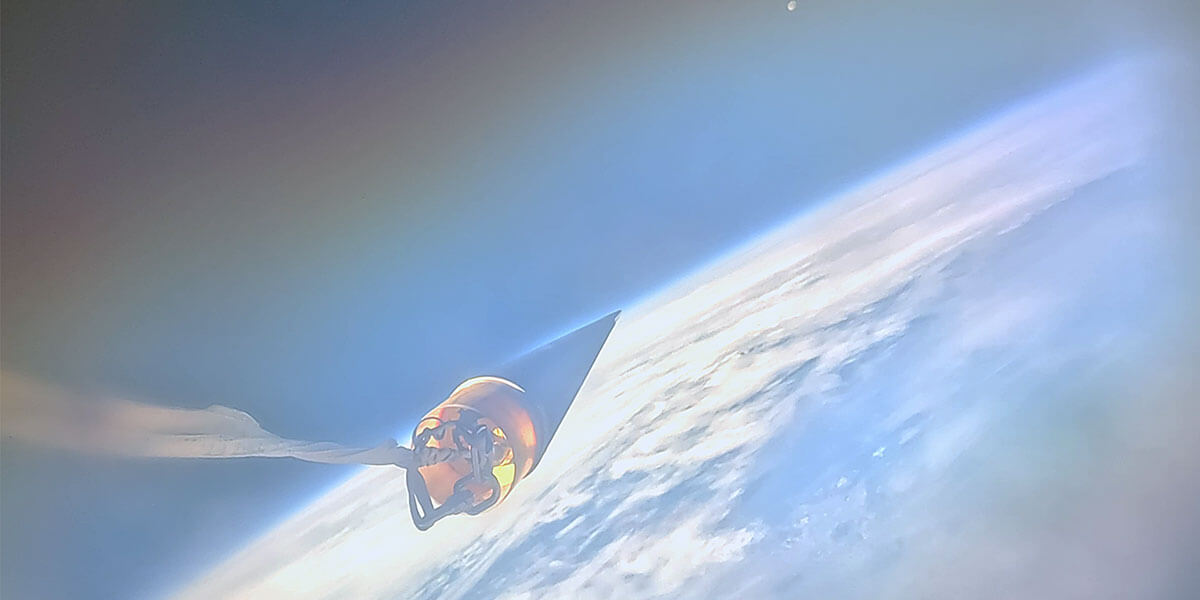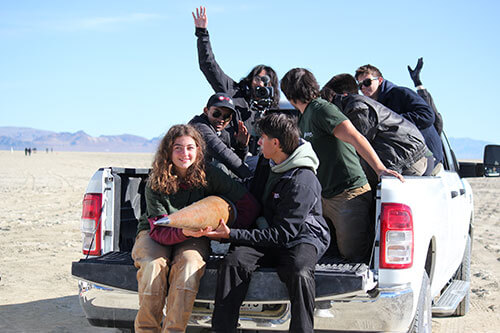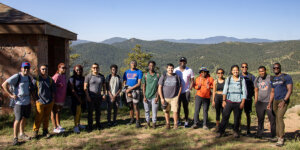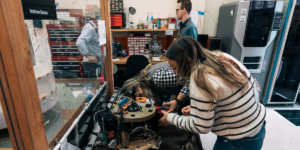
Photo from space. The nose cone of USCRPL’s rocket points towards the moon, across Earth’s horizon
Aftershock II, the latest rocket designed and built by the student-run USC Rocket Propulsion Lab (USCRPL) at the USC Viterbi School of Engineering, has broken the international altitude record – reaching further into space than any non-governmental and non-commercial group has ever flown before.
The previous 20-year record of 380,000 feet was set by Civilian Space Exploration Team back in 2004. Aftershock II beats that record by 90,000 ft.
It also builds upon the group’s record as the first and only student organization to launch a student-designed and built rocket past the Kármán line in 2019.
“This achievement represents several engineering firsts,” said Ryan Kraemer, executive engineer of USCRPL and an undergraduate student majoring in mechanical engineering. “Aftershock II is distinguished by the most powerful solid-propellant motor ever fired by students and the most powerful composite case motor made by amateurs.”
In 2019, the USCRPL Traveler IV rocket was the first collegiate-designed and built rocket to pass the Kármán line, the boundary separating Earth’s atmosphere and outer space. Since then, the student-run team have been striving to beat their own record, seeking to claim the altitude record for amateur rocketry worldwide.
The successful launch of Aftershock II took place on October 20 in the Black Rock Desert rocket launch area, Nevada (the student white paper verifying the data was posted on November 14th). Equipped with a new avionics unit and improved safety and data integration, Aftershock II reached a velocity of 5283 ft/s and Mach 5.5. The comparatively lightweight rocket amounted to 330 pounds, at a height of 13 ft and 8” diameter.
Crucially, the endurance of the rocket at hypersonic speeds was made possible by a thermal protection system that included new paint and titanium-coated fins.
“To exceed the standard we set for ourselves with Traveler IV, we had to solve many technical and operational challenges,” Kraemer explained. “Thermal protection at hypersonic speeds is a major challenge at the industry level, and the protective paint system that we developed performed perfectly, enabling the rocket to return largely intact. We also made an important upgrade to the fins, replacing the bare carbon edge of previous iterations with titanium leading edges. The titanium not only prevented fraying but actually turned blue from the intense heat during flight through anodization, which really demonstrates the extreme conditions our rocket successfully endured.”
Furthermore, the custom-designed computer systems and circuit boards were designed and built from scratch by the student team, enabling the live integration of data. This allowed for tracking of the rocket’s position during flight, gathering data and recovering the rocket on descent.

The USCRPL team with the rocket before liftoff
“This is an exceptionally ambitious project not only for a student team, but for any non-professional group of rocket engineers,” said Dan Erwin, chair of the USC Department of Astronautical Engineering. “It’s a testament to the excellence we seek to develop in our emerging astronautical engineers, who go on to achieve top roles in the space industry and in government positions. The can-do, problem-solving mindset of USCRPL students has provided a foundation for leading startups including Relativity Space and Ursa Major. If you want to see what’s next for the space industry, keep an eye on USCRPL.”
“Since its founding 20 years ago, the USC Rocket Propulsion Laboratory has made a reality of the aspirations and vision for space of countless Viterbi undergraduate students across all engineering majors,” said Dean Yannis Yortsos. “It is thrilling to see how they have now shattered not only their previous global student record of reaching the Kármán line in 2019, but also the record of any amateur team in history. This extraordinary group of students shows how to imagine, what can be done in the lab, and how to make it a reality. And throughout the 20-year history, how to translate their skills and knowledge to innovative startups.”
Published on November 15th, 2024
Last updated on November 15th, 2024













